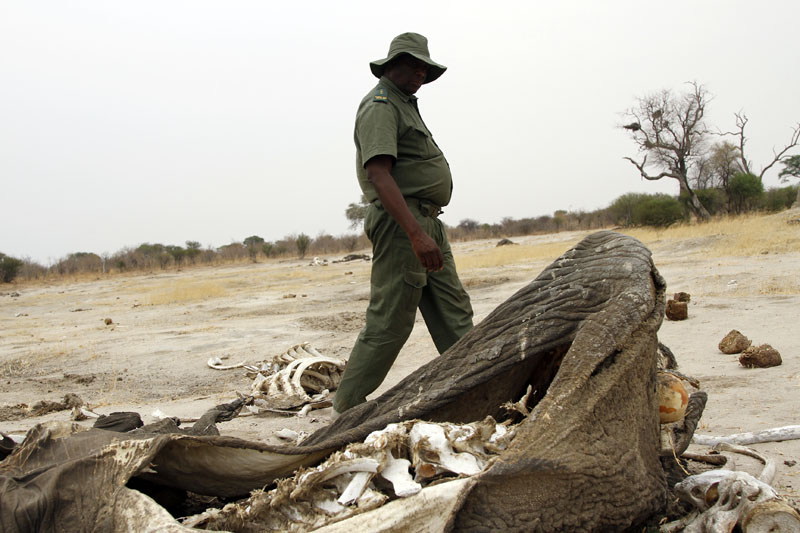
THE country could have lost over $5 million following the killing of over 100 elephants by cyanide poisoning in the vast Hwange National Park recently in what has turned out to be an ecological disaster, it has been learnt.
Wisdom Mdzungairi/Mernat Mafirakurewa
This brought the figure to $50 million after poachers killed almost 1 000 elephants in the last five years.
Between 2009-2012 some 847 elephants, at least 300 buffalo; 42 rhinos and 21 lions were killed by poaching syndicates across the country — the bulk in Hwange National Park.
Zimbabwe Parks and Wildlife Management Authority spokesperson Caroline Washaya-Moyo confirmed that already, the authority could have lost over $5 million — the replacement value of the poisoned jumbos.
According to the Zimbabwe Parks and Wildlife Management Authority Statutory Instrument 57 of 2012 CAP 20:21 gazetted in April last year, an elephant has a replacement value of $50 000.
However, the buffalo, rhino, lion and other plain game were not quantified although the cost could also run into several millions of dollars in lost revenue.
“The Statutory Instrument calls for payment for trapping of Wildlife species. It is against this background that the compensation of an elephant (tusk less, with tusks etc) has been pegged at $50 000,” Washaya-Moyo said.
- Chamisa under fire over US$120K donation
- Mavhunga puts DeMbare into Chibuku quarterfinals
- Pension funds bet on Cabora Bassa oilfields
- Councils defy govt fire tender directive
Keep Reading
This came amid disclosures that some security details, safari operators and politicians could have been involved in the Hwange jumbo saga.
Impeccable sources told NewsDay, last week the poaching syndicates also involved some top Tsholotsho Rural District Council officials, Campfire and businesspeople.
“Most of the poisoned elephants that were found in the Pelandaba communal area (on southern part of Hwange National Park) were driven out of the park area using a small plane and shepherded to poisoned waterholes outside the park where they drank, died and had horns harvested,” the sources said.
The jumbo scandal has sucked in a detective police assistant inspector Alois Gakata and his three surbodinates and businessperson Farai Chitsa among others, amid indications that Zimbabwe was losing millions of dollars in potential revenue annually through illegal wildlife harvesting.
Cyanide poisoning at the park’s salt licks has also affected the food chain, killing other game species where plains game were left to rot by the poachers.
As a result, elephants and other species were still dying en masse from the effects of the cyanide poisoning in the park.
Washaya-Moyo said: “The Zimbabwe Parks and Wildlife Management Authority has so far managed to recover a total of 51 elephant tusks during its field operations in Hwange National Park. Therefore, the authority is still making concerted efforts towards further recoveries of valuable trophies ie a balance of 123 tusks from a total of 174 tusks.”
Investigations showed that last year alone, 212 elephants were poached across the country.
Documents showed that key wildlife species illegally harvested last year included buffalo (46), kudu (74), zebra (36), impala (106), waterbuck (9), White rhino (5) Black rhino (3), lion (15), eland (11), Nyala (16), crocodiles (9) and warthog (31).
In 2011, poachers hunted down 223 elephants, buffalo (68), kudu (58), zebra (48), impala (88), waterbuck (9), Nyala (5), sable (3) and warthog (21) while in 2010, 77 elephants, 80 buffaloes, rhino (22), 9 Eland, 12 Giraffe, 63 kudus, and 20 zebras were killed and 145 elephants were poached in 2009.
US-based International Conservation Caucus Foundation (ICCF) said: “The recent rise in wildlife product prices has been met by the increased involvement of more organised, better-funded, and better-armed criminal and terrorist networks, and even militias, compounding the challenges faced by those charged with protecting the wildlife.
“Asian demand for rhino horn has set a historic price for rhino horn powder — over $30 000 per pound, making it more valuable than gold and cocaine.”
Toothless laws, corruption, weak judicial systems, and light punishments, ICCF said, allowed criminal networks to thrive on wildlife trade with little regard to risk or consequence.











